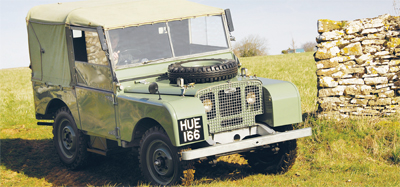October 2011 Issue of 4×4 Magazine
 Back in 1948, at the Amsterdam Motor Show, the public were amazed at the new Land Rover, designed by Maurice Wilks (although perhaps ‘designed’ is the wrong term, ‘hand-built’ more appropriate). Fast forward 63 years to this year’s Frankfurt Motor Show and the world has been well, surprised, at Gerry McGovern’s design for the replacement to the Land Rover Defender. Initial promotional photographs of Land Rover’s concept DC100 (see News, page 12) released before the Show, have resulted in forums set ablaze with indignant Land Rover enthusiasts bemoaning the horror of what McGovern has dared to do with the world’s most beloved off-roader. How could they? Sacrilege! Think of the heritage!
Back in 1948, at the Amsterdam Motor Show, the public were amazed at the new Land Rover, designed by Maurice Wilks (although perhaps ‘designed’ is the wrong term, ‘hand-built’ more appropriate). Fast forward 63 years to this year’s Frankfurt Motor Show and the world has been well, surprised, at Gerry McGovern’s design for the replacement to the Land Rover Defender. Initial promotional photographs of Land Rover’s concept DC100 (see News, page 12) released before the Show, have resulted in forums set ablaze with indignant Land Rover enthusiasts bemoaning the horror of what McGovern has dared to do with the world’s most beloved off-roader. How could they? Sacrilege! Think of the heritage!
Lost in these reactions are a couple of salient points, and to be honest, if you have been following the new models coming from Land Rover over the last few years, you have to be somewhat blinkered not to have been able to see this one coming. In today’s fi nancially restricted, global market, the present Land Rover Defender is an anachronism. You could hazard a guess that there is little, if any profit, building a present day Defender. Hoops have had to be driven through to meet the changing safety and emissions regulations, making it a basic requirement that any replacement Defender would have to be very different from the original. The present Defender is probably expensive to build, due to its ‘hand-built’ qualities. And you only have to look at the new Evoque to see that Land Rover are quite good at this. McGovern’s design team are not a bunch of crayon wielding vandals about to obliterate 60 plus years of heritage. The Evoque is undeniably Land Rover, but it’s like no other ever designed, and actually benefits from that fact.
If you can rise above the red mist and accept that perhaps ‘they’ know what they are doing, it begs a further thought. The original Land Rover is a tough, utilitarian workhorse, capable of amazing longevity and surviving even greater levels of mechanical abuse. It was also modular and can be stretched, converted, axles added, engines changed and then turned into fi re engines, ambulances, recovery trucks and that’s before you consider all the military options. At first glance at these photographs of the concept DC100, that doesn’t look likely to continue, at least not in the same way. And perhaps that’s also the point: is that the market that Jaguar Land Rover is aiming for with the new Defender? Not being party to the figures on the Jaguar Land Rover balance sheet this is just a guess, but perhaps those modular options do not bring the company much of a profit and in today’s global economy, why would you build something that you didn’t think was going to make a profit? Perhaps you can take the unrivalled heritage and brand reputation, produce a Land Rover that carries those benefits, and sell it to a new global market of owners.
Land Rover claims that the DC100 is there to ‘stimulate debate’ and that the reaction of the public will be listened to. That’s probably true, up to a point. Forgive the cynic in me, but the view of a dyed-in-the-wool Series 1 owning traditionalist may not carry much weight, since that person is unlikely to ever buy a new Defender. Time has marched on, and the ‘original’ Land Rover is not of this time. Perhaps Jaguar Land Rover will continue with a Classic Defender range, or sell the tooling to an enterprising entrepreneur who will build old school ‘Defenders’ under licence. Who knows? One thing you can be sure of, however, ‘they’ do know what they are doing. Maurice Wilks might even have approved.
 Nigel Fryatt, Editor
Nigel Fryatt, Editor

To buy your copy of the latest issue of 4×4 Magazine click here


